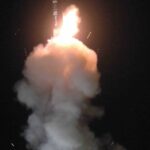
- Answers increasing need to augment capabilities of manned aircraft with unmanned platforms
- Showcases foreseen capabilities such as low observability and armament
By Vikas Gupta
Defence News of India, 4th June 24
Air power theorists have agreed for years that manned aircraft have had their day. They say too much planning and redundant survival systems in combat aircraft are now devoted to protecting human crew members.
A decade ago, it was believed that the current, 5th generation of manned fighters – America’s F-35 lightning II; the F-22 Raptor, the Russian Sukhoi-57; the Chinese J-31 Shenyang and F-20 Chengdu and India’s Advanced Medium Combat Aircraft (AMCA) – would be followed by unmanned drones that would be directed to their targets remotely, where their weapon-loads would be autonomously released from stand-off distances.
Indian Air Force (IAF) planners were amongst the few sceptics of autonomous warfare. In the Aero India 2021 air show in February 2021, Hindustan Aeronautics Ltd (HAL) presented a vision called the Combat Air Teaming System (CATS), a combination of manned and unmanned systems that would operate in tandem in wartime, reinforcing each other’s strengths and capabilities.
Global major, Airbus, has adopted this concept too. At the International Aerospace Exhibition ILA Berlin that kicks off on Wednesday, Airbus will present its new “wingman” concept. In military aviation, a “wingman” is a pilot in another friendly aircraft that protects and supports the flight lead, delivering more tactical options and thus contributing to mission success.
In the Airbus concept, the “wingman” will operate in much in the same way – except that she would not be a pilot. The “wingman” would be a combat drone, commanded by a pilot in a current combat aircraft, such as the Eurofighter, taking on high-risk mission tasks that would pose an unacceptably large threat to manned-only aircraft.
The 1:1 model, which Airbus will be exhibiting from June 5 to 9 on its static display at ILA, is similar to a “show car” that is used as a design exercise by the automotive industry.
“The wingman model showcases all of the foreseen capabilities required, such as low observability, the integration of various armaments, advanced sensors, connectivity and teaming solutions. Not all of what is on display may find its way into series production,” stated a Ministry of Defence (MoD) press release.
“In this aspect, the model on display at ILA Berlin will serve as a foundation and catalyst to drive the design requirements for each generation of the “wingman,” said the MoD.
Based on the current concept, the “wingman” is intended to augment the capabilities of current manned combat aircraft with uncrewed platforms carrying weapons and other effectors.
“The German Air Force has expressed a clear need for an unmanned aircraft flying with and supporting missions of its manned fighter jets before the Future Combat Air System will be operational in 2040,” said Michael Schoellhorn, Chief Executive of Airbus Defence and Space.
“Our Wingman concept is the answer. We will further drive and fine-tune this innovation made in Germany, so that ultimately we can offer the German Air Force an affordable solution with the performance it needs to maximise the effects and multiply the power of its fighter fleet for the 2030s,” he said.
“The wingman’s tasks can range from reconnaissance to jamming targets and engaging [them] on the ground or in the air with precision guided munitions or missiles. Pilots in manned aircraft acting as command fighters will always have control of the mission,”
“They are always the final decision-making authority, while benefiting from the protection and smaller risk exposure that the delegation of tactical taskings to unmanned systems offers,” said Airbus.






